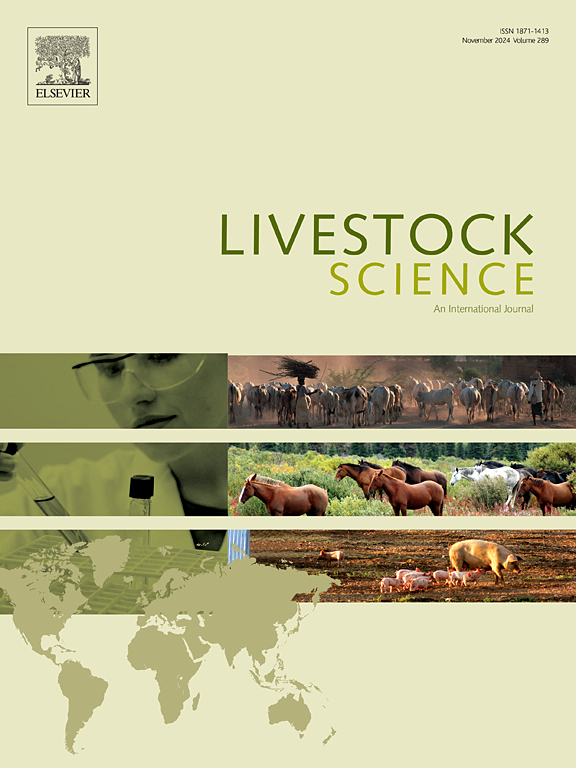Mangalarga Marchador马的形态和步态特征因子分析中潜在变量的遗传参数
IF 1.9
3区 农林科学
Q2 AGRICULTURE, DAIRY & ANIMAL SCIENCE
引用次数: 0
摘要
我们的目的是评估与传统的多变量分析相比,计算需求的减少,以及通过对MM马的形态和步态特征的因素分析,在贝叶斯框架内估计其遗传参数,识别具有生物学相关性的潜在变量(伪表型)。收集了50,172匹马的15个形态和性能指标:马肩高、群高、胸围、炮骨周长、头长、颈长、背长、腰长、群长、肩长、体长、头宽、群宽、形态功能点、步态和总分。该数据集由巴西Mangalarga Marchador马饲养者协会(ABCCMM)提供。进行因子分析,提取了6个潜在因素,解释了数据总方差的73%。其中,“身高”(F1)、“步态能力”(F2)、“健壮性”(F3)、“头部大小”(F4)四个因素具有生物学相关性,并在遗传分析中进行探讨。F1和F4的遗传力估计为中高量级(分别为0.47±0.10和0.39±0.10)。F1与F4(0.80±0.00)、F1与F3(0.44±0.01)、F3与F4(0.33±0.01)的遗传相关性为0 ~高。因子分析被证明是一个适当的替代减少变量的维数,因此,计算需求在遗传评估的MM马。中等遗传力表明根据这些性状进行有效选择的可能性。总的来说,相关性表明,因素的选择可能导致其他因素的遗传收益从负到高不等。因此,推荐两个因素作为MM马育种计划的选择标准,这可能有助于品种的遗传改良。本文章由计算机程序翻译,如有差异,请以英文原文为准。
Genetic parameters for latent variables derived from factor analysis of morphological and gait traits in Mangalarga Marchador horses
Our aim was to assess the reduction of computational demand compared to traditional multivariate analyzes, as well as identify latent variables with biological relevance (pseudo-phenotypes) through a factor analysis for morphological and gait traits in MM horses, estimating their genetic parameters within a Bayesian framework. A total of 15 morphological and performance traits were collected from 50,172 horses: withers height, croup height, thoracic perimeter, cannon bone perimeter, head length, neck length, back and loin length, croup length, shoulder length, body length, head width, croup width, morphofunctional points, gait and total points. The dataset was provided by the Brazilian Association of Mangalarga Marchador Horse Breeders (ABCCMM). A factor analysis was performed and six latent factors that explained 73 % of the total variance of the data were extracted. From them, four factors showed biological relevance, namely: "height" (F1), "gait ability" (F2), "robustness" (F3), and "head size" (F4), and were explored in the genetic analysis. The heritability estimates for F1 and F4 were of moderate to high magnitudes (0.47 ± 0.10 and 0.39 ± 0.10 for F1 and F4, respectively). The genetic correlations ranged from zero to high magnitudes, with notable values observed between F1 and F4 (0.80 ± 0.00), F1 and F3 (0.44 ± 0.01), and F3 and F4 (0.33 ± 0.01). The factor analysis proved to be an adequate alternative for reducing the dimensionality of variables and, consequently, the computational demand in the genetic evaluation of MM horses. Moderate heritabilities indicate the possibility of effective selection of horses based on these traits. In general, the correlations suggest that the selection of factors may result in genetic gains ranging from negative to high for other factors. Therefore, two factors are recommended to be used as selection criteria in MM horse breeding programs, which could contribute to the genetic improvement of the breed.
求助全文
通过发布文献求助,成功后即可免费获取论文全文。
去求助
来源期刊

Livestock Science
农林科学-奶制品与动物科学
CiteScore
4.30
自引率
5.60%
发文量
237
审稿时长
3 months
期刊介绍:
Livestock Science promotes the sound development of the livestock sector by publishing original, peer-reviewed research and review articles covering all aspects of this broad field. The journal welcomes submissions on the avant-garde areas of animal genetics, breeding, growth, reproduction, nutrition, physiology, and behaviour in addition to genetic resources, welfare, ethics, health, management and production systems. The high-quality content of this journal reflects the truly international nature of this broad area of research.
 求助内容:
求助内容: 应助结果提醒方式:
应助结果提醒方式:


